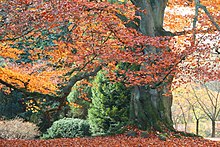**Description of Beech**:
– Beeches are monoecious, with male and female flowers on the same plant.
– Female flowers are in pairs, while male flowers are wind-pollinating catkins.
– Beech nuts, or mast, are found in small burrs that drop in autumn.
– Leaves are 5–15 cm long, 4–10 cm broad, and can be entire or sparsely toothed.
– Beech nuts have a bitter taste and high tannin content.
**Taxonomy and Species**:
– Two subgenera: Engleriana (East Asia) and Fagus (Europe).
– European beech has complex classification with different proposed names.
– Basal group in the Fagaceae family evolution.
– Species include Fagus chienii, Fagus crenata, Fagus engleriana, Fagus grandifolia, and Fagus hayatae.
**Distribution and Habitat**:
– European beech common in north-central Europe.
– Balkans host oriental and Crimean beech.
– Beech marks the border between deciduous and pine forest zones.
– Widely planted for hedging and in deciduous woodlands.
– Not native to Ireland but widely planted; native to parts of England.
**Ecology and Diseases**:
– Grows on various soil types, casting dense shade.
– Forms beech-maple climax forests in North America.
– Beech blight aphid is a common pest; thin bark scars easily.
– Diseases include beech bark disease and beech leaf disease.
– Beech leaf disease spread by nematode, first discovered in Ohio in 2012.
**Cultivation and Uses**:
– European beech commonly grown as an ornamental tree.
– Used for furniture, flooring, and engineering, including military rifle stocks.
– Excellent firewood; used in beer production and smoking meats.
– Modal textile made from pulped beech wood.
– Various varieties in cultivation, with historical and cultural significance.
Beech (Fagus) is a genus of deciduous trees in the family Fagaceae, native to temperate Eurasia and North America. Recent classifications recognize 10 to 13 species in two distinct subgenera, Engleriana and Fagus. The Engleriana subgenus is found only in East Asia, distinctive for its low branches, often made up of several major trunks with yellowish bark. The better known Fagus subgenus beeches are high-branching with tall, stout trunks and smooth silver-grey bark. The European beech (Fagus sylvatica) is the most commonly cultivated.
| Beech | |
|---|---|

| |
| European beech (Fagus sylvatica) | |
| Scientific classification | |
| Kingdom: | Plantae |
| Clade: | Tracheophytes |
| Clade: | Angiosperms |
| Clade: | Eudicots |
| Clade: | Rosids |
| Order: | Fagales |
| Family: | Fagaceae |
| Subfamily: | Fagoideae K.Koch |
| Genus: | Fagus L. |
| Type species | |
| Castanea fagus | |
| Species | |
|
See text | |
The European species Fagus sylvatica yields a utility timber used for furniture construction, flooring and engineering purposes, in plywood, and household items. The timber can be used to build homes.
Beechwood makes excellent firewood. Slats of washed beech wood are spread around the bottom of fermentation tanks for Budweiser beer. Beech logs are burned to dry the malt used in some German smoked beers. Beech is also used to smoke Westphalian ham, andouille sausage, and some cheeses.
